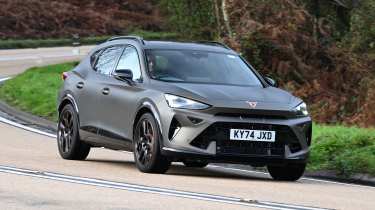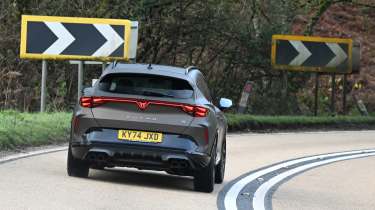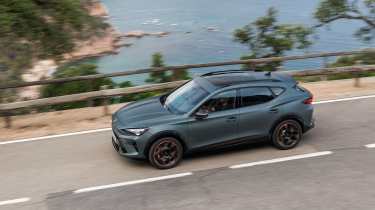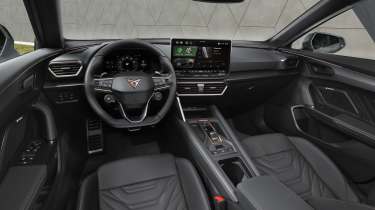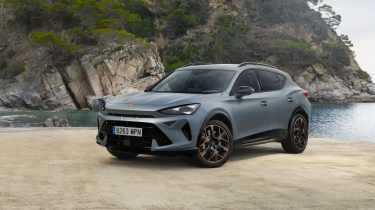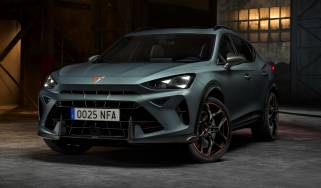Cupra Formentor VZ 2025 review – a Golf R disguised as a family car
Cupra’s top-spec Formentor has the same 328bhp engine and four-wheel drive tech as the Volkswagen Golf R. How does that feel in a taller, more practical crossover?
The Formentor is the most popular model in Cupra’s lineup by quite some margin, and for good reason. Sharp looks and pleasant handling in a practical compact SUV package make it a desirable offering for the masses, and it’s been given a comprehensive update since it first went on sale in 2020. This includes a design overhaul inside and out, with tweaks to its powertrain and chassis designed to make the range-topping VZ models more engaging than before.
The version we’re testing here is the 2-litre petrol VZ – the most driver focused of all the Formentors. It has well over 300bhp and four-wheel drive tech you’d normally find on a Volkswagen Golf R or Audi RS3. Are those ingredients wasted in a family crossover, or is the Formentor a practical, genuinely exciting alternative to a normal hot hatch?
Engine, gearbox and technical highlights
The Formentor is based on the Volkswagen Group’s MQB Evo platform, which you’ll find under the latest Golf, Audi A3 and other new Cupra models. Kicking off the range is a 1.5-litre petrol version with 148bhp and, shock horror, a manual transmission. Above that there’s a 201bhp plug-in hybrid 1.5-litre powertrain capable of up to 62 miles of electric running.
More reviews
Then come the hotter versions, available in VZ trim. There’s another 1.5-litre hybrid but this time with 268bhp, and a 2-litre turbocharged four-pot topping the range with either 261bhp or a Golf R-matching 328bhp. That’s 22bhp more than the original Formentor, with torque unchanged at 310lb ft. Tweaks to throttle mapping and transmission response have also been designed to improve urgency on the whole.
Lesser Formentors are front-wheel drive, but the flagship uses a 4Drive system that drives the rear axle through a new torque splitter diff. It’s the same tech you’ll find on an Audi RS3, utilising an electronically-controlled multi-plate clutch to distribute power and shape the balance of the car, overdriving the outside rear wheel if it needs it.
The brakes on the new car have also been upgraded, with the VZ3 receiving larger 375mm, six-piston Akebono items on the front axle and 310mm discs at the rear (357 and 310mm discs are standard elsewhere in the range).
Performance, ride and handling
Initial impressions are that the Formentor is refined for motorway miles, with low levels of wind noise, tyre roar and a relaxed feel to the damping in its softer modes (there are fifteen settings to choose from). On undulating tarmac, it’s worth moving towards the middle of the scale to prevent the body moving too freely, and this causes it to pick up more surface imperfections with a busier ride overall. It’s a compromise, but still perfectly livable.
For a crossover, the chassis is nimble and confidence inspiring, too. Weighing 1566kg (incidentally a smidge lighter than a Leon Estate) it doesn’t feel light on its feet, but it’s more hunkered down and agile than a typical warmed up small SUV, like a Volkswagen T-Roc R or Cupra’s own Terramar in 261bhp form. The Formentor is noticeably quicker than either of these too, feeling as punchy as its 4.9sec 0-62mph time suggests. There’s solid shove in the mid-range once the turbo comes on song, and while the sound and delivery at the top end aren’t that inspiring, it’s a flexible, very effective powerplant.
Push harder and the new torque splitter diff makes the Formentor more playful than before, helping the car neutralise and even nudge into oversteer under full throttle (there’s a drift mode to explore this fully). The sense of rotation can sometimes feel artificial on the limit, but overall the new diff gives the Formentor a welcome dynamic edge, and one you won’t find in many comparable crossovers.
The steering lacks the fine feedback we’d really like, but given the constraints of the platform, it’s a solid effort. In standard modes it’s very light, with not much heft throughout the range of motion, but Cupra mode increases weight off centre to provide an improvement in sense of accuracy. A lack of feedback and response off centre in its standard mode can make it tricky to place the front wheels on initial turn in, but it provides just enough precision to make it pleasant to drive spiritedly when the conditions allow.
Despite the Formentor’s relatively high kerbweight, the brakes inspire confidence with strong initial bite and a resistance to fade even on the downhill sections of the route we tested them on. They are a little hard to modulate at low speeds, but this is likely something you could quickly become accustomed to.
Design, interior and tech
Most notable at first glance are the changes Cupra has made to its exterior. While that tight, distinctive coupe-SUV shape remains, a more angular ‘shark nose’ front bumper has been applied, with its headlights (LED matrix as standard on the range-topper) updated to match. The rear has received the same treatment, with a more angular aesthetic and a full width lightbar which now incorporates an illuminated Cupra badge, matching the design changes on the new Leon.
While platform constraints (and budgets) make it near-impossible to redesign each and every element of the car, Cupra has made a real effort to improve the Formentor’s interior – particularly the old, fiddly HMI system. Like all new MQB Evo Volkswagen and Audi products, the central touch sliders are now illuminated, with the primary display larger (12.9-inches) and snappier than before. There’s also an improved 12-speaker, 423-watt Sennheiser sound system available as an option on the VZ3. Materials are noticeably more premium (and sustainable) than in the previous car, and there are fewer hard plastics too. Unfortunately the cheap-feeling centre console and stubby shifter are here to stay, but from the improved ambient lighting to the uprated materials, it all feels more polished than before.
Opt for the VZ3 range-topper we’re driving and you even get standard carbonfibre Sabelt ‘CUPBucket’ seats, lowering the driving position, adding bolstering and recycled microsuede upholstery. These seats are also available in the Leon and are of a design and finish you'd expect to find in a much more expensive car. Don’t think they sacrifice comfort for figure-hugging support either – we spent hours in them without any sign of discomfort, although your mileage may vary.
Price and rivals
The Formentor starts from a reasonable £34,910, but for the more generously-specced VZ, you’ll need at least £43,495. The 328bhp version is more again, costing from £48,605. The compact SUV market is as popular as ever and the Formentor has plenty of rivals, spanning from the £45,465 Volkswagen T-Roc R to the £53,515 BMW X2 M35i and the £55,320 GLA35 from Mercedes-AMG.
The T-Roc might be a few grand cheaper, but it’s more dated and less technically advanced, with an old-generation interior and lacking the Cupra’s level of performance and four-wheel drive tech. From a value perspective, the Formentor compares favourably to the BMW and Mercedes, lacking their badge kudos but offering more power than both, with the X2 putting out 296bhp and the AMG 302bhp (plus a 14bhp boost from an electric motor).
The Formentor is capable and likable as crossovers go, but we’d still rather a less compromised, more dynamic fast estate. From that sphere there’s the Skoda Octavia vRS, packing a 261bhp Golf GTI engine for seven grand less than the hottest Formentor, or Cupra’s own Leon Estate, which gets you the same engine as the crossover for a little less money.
